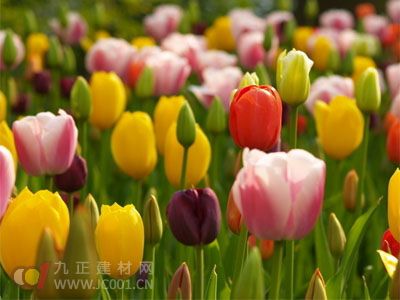Tulips are native to the Mediterranean coast and central Asia. In China, they are known by several names, including grass musk, red and blue flowers, peony lilies, ocean lotus, and daffodils. They belong to the lily family and are widely appreciated for their beauty and versatility in gardens and celebrations.
**Morphological Characteristics**
Tulips are perennial herbs that typically grow between 30 to 50 cm tall. Their bulbs are flat and conical, covered with a brown membrane. The plant usually has 3 to 5 leaves. The flowers are large, cup-shaped, and stand upright, often in shades of magenta, with the base sometimes appearing black or purple. The seed capsules are flat, and the natural flowering period is from March to May, with fruits ripening between April and June. Although the Netherlands is the most famous center for tulip cultivation, these flowers have become popular around the world as ornamental plants. They are commonly used in festivals, weddings, and home decor, adding a touch of elegance and exotic charm to any space.

**Key Management Tips**
1. **Watering**: Tulips prefer slightly dry soil. When the buds begin to form, you can increase watering to encourage blooming and enhance the plant's ornamental value. During the entire flowering process, it's important to follow the principle of low water when temperatures are low, and more water when it's warmer.
2. **Fertilization**: Since tulip bulbs store a lot of nutrients, fertilization isn't always necessary for healthy flowering. However, during the early growth stage—when the plant has 2 to 3 leaves—and after the flower buds appear, applying a diluted phosphorus and potassium-rich liquid fertilizer can help ensure strong blooms.
3. **Light**: Tulips require at least 8 hours of direct sunlight daily. This helps them produce more energy through photosynthesis, supporting healthy growth and ensuring the flowers open properly.
4. **Pest and Disease Control**: Common issues in tulip cultivation include white scale, brown spot, black rot, mosaic virus, and various fungal diseases. It’s important to maintain good hygiene and use disease-free bulbs to prevent these problems. Pests like nematodes, mites, and aphids can also affect the plants, but with proper care and healthy bulbs, these issues are usually manageable.
5. **Flowering Care**: After the flowers bloom, avoid keeping the soil too wet or too dry. Stop fertilizing and keep the area bright but not overly sunny. Maintain a cool temperature (around 8°C to 12°C) to extend the flowering period. High temperatures can cause the flowers to wilt quickly, so a cooler environment is ideal for maintaining their beauty.
Farm Fence
1. Farm Fence: This is a type of fence that is used on farms to keep animals in specific areas and prevent them from wandering off. It is usually made from wood, metal, or a combination of both.
2. Galvanized Wire Fence: This is a type of fence made from steel wire that has been coated with a layer of zinc to prevent rusting and corrosion. It is commonly used in agricultural settings due to its durability and strength.
3. Farm Fence Wire: This is a type of wire that is specifically designed for use in farm fences. It is usually made from high-tensile steel, which is strong and resistant to stretching. It can be used to create a variety of fence types, including Barbed Wire, woven wire, and electric fences.
4. Horse Fence Wire: This is a type of wire fence that is specifically designed for use with horses. It is usually made from high-tensile steel and is designed to be safe and effective at keeping horses contained. It is often coated with a smooth material to prevent horses from getting injured if they come into contact with the fence.
Farm Fence,Galvanized Wire Fence,Farm Fence Wire,Horse Fence Wire
Hebei Aibuer trading co., Ltd , https://www.ablehardwares.com